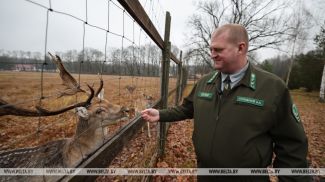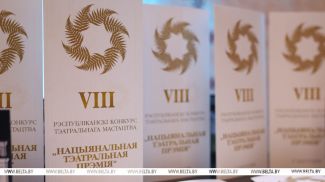
Even if Belarus does not feature in your travel plans yet, you should know that this country is not short of options for travelers. In addition to visiting historical landmarks, tourists can tour the country’s industry giants, try local food, enjoy its breathtaking nature. Visiting Belarus can turn into one-in-a-lifetime experience.
Belarusian malyavanka in Zaslavl
For a dose of history and culture, make your way to Zaslavl, one of Belarus’ oldest towns. This little town near Minsk was founded more than a thousand years ago. Polotsk Princess Ragneda and her son Izyaslav were exiled there. In Zaslavl she converted to Christianity and founded the first Christian monastery in Eastern Europe. Belarus’ first bastion castle was built there; its moats and ramparts have been well preserved to this day. Belarusian educator and Bible translator Symon Budny read his sermons in the local Transfiguration Church.
First of all, we suggest visiting the Belarusian Malyavanka Museum that opened in 2023. Malyavankas are traditional painted carpets. In this museum you can see and feel the soul of the Belarusian people.

Such carpets were very popular in Belarus in the 1920s-1960s. After devastating wars, impoverished people sought every way to bring some beauty into their lives. Malyavankas were quite simple to create, which made them a very common household item.
In the museum, you can see 11 works by Alena Kish that were created in the Primitivism style. Having seen Alena's malyavankas once, you will unmistakably recognize her signature style later, because her craftwork is one of a kind in Belarusian folk art. There are also malyavankas by Yazep Drozdovich dubbed the Belarusian Leonardo da Vinci, an eternal traveler and dreamer. An entire section is dedicated to his work, while the museum holds more than 30 of his works.
All in all, the Belarusian Malyavanka Museum has about 300 exhibits. The museum is part of the Historical and Cultural Museum-Reserve Zaslavl. Other facilities of the complex are also worth visiting.
Zhodino giants

In the middle of the 17th century, Prince Boguslaw Radziwill founded the town of Boguslaw Pole, which was later renamed Zhodino. Now this city is known for the production of the world-famous BelAZ dump trucks. And you can see the manufacturing process with your own eyes.
The tour begins with the Labor Glory Museum, where you can learn the company’s history, see models of all the machines produced, photos documenting the construction of the plant. The main conveyor and workshops will be shown to you only from the tour bus. Why? Do not forget that employees care about your safety. But at the exhibition site you will be able to see giant dump trucks from close distance and even get into the driver's cabin.
By the way, did you know that the company’s largest dump truck got into Guinness World Records? It transported 503.5 tonnes of cargo - more than any other dump truck of any other manufacturer in the world.
And if you want to ride a BelAZ truck (boys love it, even if they are a little over 60), you will be able to do it.
Belarus’ most famous medieval castle

The most famous Belarusian medieval castle is located in the urban settlement of Mir, Korelichi District, Grodno Oblast.
The exact date of the beginning of the Mir Castle construction has not been established. It is known that it was the first half of the 16th century, and the owner was Duke Yuri Ilyinich. After a fairly short time, the dynasty died out, and Mir passed to the Radziwills. After that it was owned by the Wittgensteins and the Svyatopolk-Mirskys.


Belarusian malyavanka in Zaslavl
For a dose of history and culture, make your way to Zaslavl, one of Belarus’ oldest towns. This little town near Minsk was founded more than a thousand years ago. Polotsk Princess Ragneda and her son Izyaslav were exiled there. In Zaslavl she converted to Christianity and founded the first Christian monastery in Eastern Europe. Belarus’ first bastion castle was built there; its moats and ramparts have been well preserved to this day. Belarusian educator and Bible translator Symon Budny read his sermons in the local Transfiguration Church.
First of all, we suggest visiting the Belarusian Malyavanka Museum that opened in 2023. Malyavankas are traditional painted carpets. In this museum you can see and feel the soul of the Belarusian people.

Such carpets were very popular in Belarus in the 1920s-1960s. After devastating wars, impoverished people sought every way to bring some beauty into their lives. Malyavankas were quite simple to create, which made them a very common household item.
In the museum, you can see 11 works by Alena Kish that were created in the Primitivism style. Having seen Alena's malyavankas once, you will unmistakably recognize her signature style later, because her craftwork is one of a kind in Belarusian folk art. There are also malyavankas by Yazep Drozdovich dubbed the Belarusian Leonardo da Vinci, an eternal traveler and dreamer. An entire section is dedicated to his work, while the museum holds more than 30 of his works.
All in all, the Belarusian Malyavanka Museum has about 300 exhibits. The museum is part of the Historical and Cultural Museum-Reserve Zaslavl. Other facilities of the complex are also worth visiting.
Zhodino giants

In the middle of the 17th century, Prince Boguslaw Radziwill founded the town of Boguslaw Pole, which was later renamed Zhodino. Now this city is known for the production of the world-famous BelAZ dump trucks. And you can see the manufacturing process with your own eyes.
The tour begins with the Labor Glory Museum, where you can learn the company’s history, see models of all the machines produced, photos documenting the construction of the plant. The main conveyor and workshops will be shown to you only from the tour bus. Why? Do not forget that employees care about your safety. But at the exhibition site you will be able to see giant dump trucks from close distance and even get into the driver's cabin.
By the way, did you know that the company’s largest dump truck got into Guinness World Records? It transported 503.5 tonnes of cargo - more than any other dump truck of any other manufacturer in the world.
And if you want to ride a BelAZ truck (boys love it, even if they are a little over 60), you will be able to do it.
Belarus’ most famous medieval castle

The most famous Belarusian medieval castle is located in the urban settlement of Mir, Korelichi District, Grodno Oblast.
The exact date of the beginning of the Mir Castle construction has not been established. It is known that it was the first half of the 16th century, and the owner was Duke Yuri Ilyinich. After a fairly short time, the dynasty died out, and Mir passed to the Radziwills. After that it was owned by the Wittgensteins and the Svyatopolk-Mirskys.
The castle was repeatedly destroyed and restored and was neglected for almost the entire 19th century. At the beginning of the 20th century, the park was replanted and the family chapel of the Svyatopolk-Mirskys was built. On its main façade, the face of Christ the Almighty (Pantocrator) is laid out in mosaic. Wherever you stand in front of the building, Christ's gaze will be directed towards you.

Restoration works were conducted in the castle before the start of the Great Patriotic War, but the reconstruction was never completed. During the war, the castle housed a Jewish ghetto and a prisoner of war camp. After the victory and until 1956, a part of the castle was used for housing and the chapel - as a grain warehouse.
A new restoration effort kicked off in the late 1980s. It lasted for almost 30 years. In 2000 the castle was listed by UNESCO as a World Heritage Site.
Today the castle amazes with its grandeur and monumentality. Little is known about many similar medieval buildings, except for their defensive capabilities. Here, however, visitors can delve deeper in the Mir Castle history, learning details about its owners’ life and work.

Mir Castle has been used as a movie set numerous times since 1928. It can be spotted in such films as “Nobleman Zavalnya, or Belarus in Fantastic Stories”, “Sniper. Weapon of Vengeance”, ”1812. The Ballad of Uhlans” and many others.
After visiting the castle, wander the streets of the same-name village. Pay a visit to St. Nicholas Convent, built in the early 17th century, the Trinity Church of the 16th century, and St. George’s Church of the 20th century. The buildings and the place itself resemble the spirit of the 19th century.
In the land of blue lakes

Glublya, Glubelka, Karasik, Yachmenek, Omsharnik, Svino... These are just a few lakes located in the Blue Lakes National Park. There are many more, like Mertvoye, Ilginia, Bolduk, Bolduchitsa, Boltsik, Glukhoye.

The park offers wonderful eco-trails to explore the local nature. Four- and seven-kilometer routes will be ideal for those who want to take a walk, see deep ravines and rushing, almost mountainous river Stracha from the observation deck, take a swim in the clearest lakes. You can also climb the observation tower on Lysaya Gora [Bald Mountain] and get an almost bird’s-eye view of the landscapes.
Those who train to climb Everest will find the local mountain Glubverest interesting for ascending.
Those who want to test their strength can build their own route of 20km or more. It will be a great opportunity to discover a waterfall on the ruins of a water mill as well as “boiling” springs, cross the river on a rope bridge (if you are afraid to do it, you will have to wade it through), and enjoy the fragrant air of pine forests, marsh grasses and the spirit of adventure.
Supreme Commander-in-Chief's Headquarters

At the height of World War I, Mogilev was virtually the capital city of the Russian Empire. In August 1915, the Russian Army Headquarters under the leadership of Emperor Nicholas II was stationed in the city. Commanding and top officers, part of the Court, and leading theater companies arrived in Mogilev together with the emperor.
It is worth noting that back in 1780 Mogilev played host to a meeting of Empress Catherine II and Holy Roman Emperor Joseph II.
St. Nicholas Convent keeps one of the coins which Nicholas II handed out when leaving the church. The coin used to be possessed by a local resident, who later donated it to the church.
The Mogilev Oblast Drama Theater is worth a visit, too. It was regularly attended by the emperor, and the box where he watched performances has been called the Imperial Box ever since.

Take a walk along the Square of Glory, as there used to be a set of buildings that housed the Supreme Commander-in-Chief's Headquarters. Unfortunately, only one building survived to the present day. Today it houses the local history museum. It is said that it was here that Nicholas II said goodbye to the officers of the Supreme Commander-in-Chief's Headquarters after his abdication in order to leave the Mogilev railway station for Tsarskoye Selo, where he was later arrested.
On the square there stands the city hall, which observation deck offers a picturesque view of the Dnieper floodplain. Here, a fanfare of a mechanical trumpeter can be heard at noon. Nearby, in the Podnikolye Park, where St. Nicholas Convent is located, the royal family used to walk along the Dnieper embankment, and we highly recommend you to do the same. And, of course, do not forget to pay a visit to the church.
There is so much more to Mogilev that meets the eye, from walking along the pedestrian Lenin Street and looking at the stars with the Stargazer to peeking in St. Stanislaus Church and admiring the Russian architecture of the city.
A new restoration effort kicked off in the late 1980s. It lasted for almost 30 years. In 2000 the castle was listed by UNESCO as a World Heritage Site.
Today the castle amazes with its grandeur and monumentality. Little is known about many similar medieval buildings, except for their defensive capabilities. Here, however, visitors can delve deeper in the Mir Castle history, learning details about its owners’ life and work.

Mir Castle has been used as a movie set numerous times since 1928. It can be spotted in such films as “Nobleman Zavalnya, or Belarus in Fantastic Stories”, “Sniper. Weapon of Vengeance”, ”1812. The Ballad of Uhlans” and many others.
After visiting the castle, wander the streets of the same-name village. Pay a visit to St. Nicholas Convent, built in the early 17th century, the Trinity Church of the 16th century, and St. George’s Church of the 20th century. The buildings and the place itself resemble the spirit of the 19th century.
In the land of blue lakes

Glublya, Glubelka, Karasik, Yachmenek, Omsharnik, Svino... These are just a few lakes located in the Blue Lakes National Park. There are many more, like Mertvoye, Ilginia, Bolduk, Bolduchitsa, Boltsik, Glukhoye.

The park offers wonderful eco-trails to explore the local nature. Four- and seven-kilometer routes will be ideal for those who want to take a walk, see deep ravines and rushing, almost mountainous river Stracha from the observation deck, take a swim in the clearest lakes. You can also climb the observation tower on Lysaya Gora [Bald Mountain] and get an almost bird’s-eye view of the landscapes.
Those who train to climb Everest will find the local mountain Glubverest interesting for ascending.
Those who want to test their strength can build their own route of 20km or more. It will be a great opportunity to discover a waterfall on the ruins of a water mill as well as “boiling” springs, cross the river on a rope bridge (if you are afraid to do it, you will have to wade it through), and enjoy the fragrant air of pine forests, marsh grasses and the spirit of adventure.
Supreme Commander-in-Chief's Headquarters

At the height of World War I, Mogilev was virtually the capital city of the Russian Empire. In August 1915, the Russian Army Headquarters under the leadership of Emperor Nicholas II was stationed in the city. Commanding and top officers, part of the Court, and leading theater companies arrived in Mogilev together with the emperor.
It is worth noting that back in 1780 Mogilev played host to a meeting of Empress Catherine II and Holy Roman Emperor Joseph II.
St. Nicholas Convent keeps one of the coins which Nicholas II handed out when leaving the church. The coin used to be possessed by a local resident, who later donated it to the church.
The Mogilev Oblast Drama Theater is worth a visit, too. It was regularly attended by the emperor, and the box where he watched performances has been called the Imperial Box ever since.

Take a walk along the Square of Glory, as there used to be a set of buildings that housed the Supreme Commander-in-Chief's Headquarters. Unfortunately, only one building survived to the present day. Today it houses the local history museum. It is said that it was here that Nicholas II said goodbye to the officers of the Supreme Commander-in-Chief's Headquarters after his abdication in order to leave the Mogilev railway station for Tsarskoye Selo, where he was later arrested.
On the square there stands the city hall, which observation deck offers a picturesque view of the Dnieper floodplain. Here, a fanfare of a mechanical trumpeter can be heard at noon. Nearby, in the Podnikolye Park, where St. Nicholas Convent is located, the royal family used to walk along the Dnieper embankment, and we highly recommend you to do the same. And, of course, do not forget to pay a visit to the church.
There is so much more to Mogilev that meets the eye, from walking along the pedestrian Lenin Street and looking at the stars with the Stargazer to peeking in St. Stanislaus Church and admiring the Russian architecture of the city.














